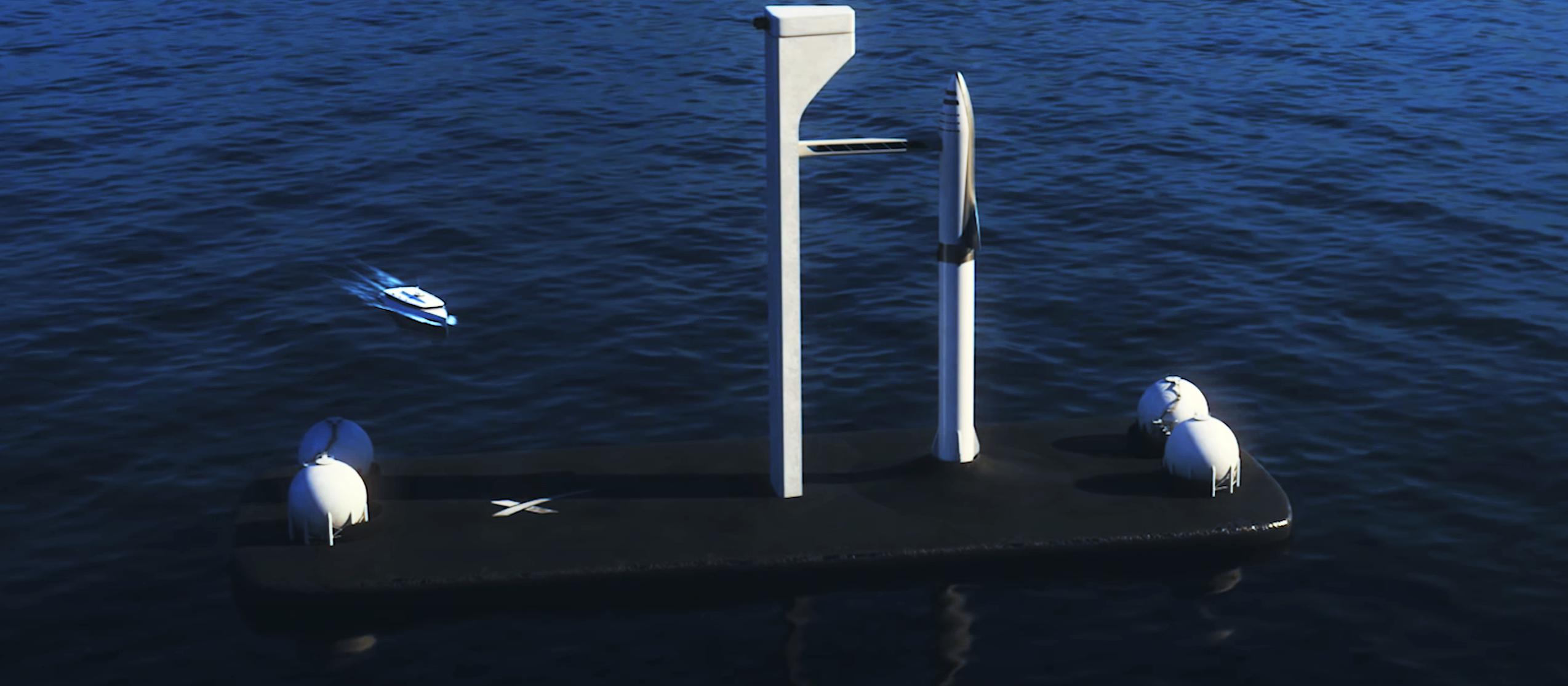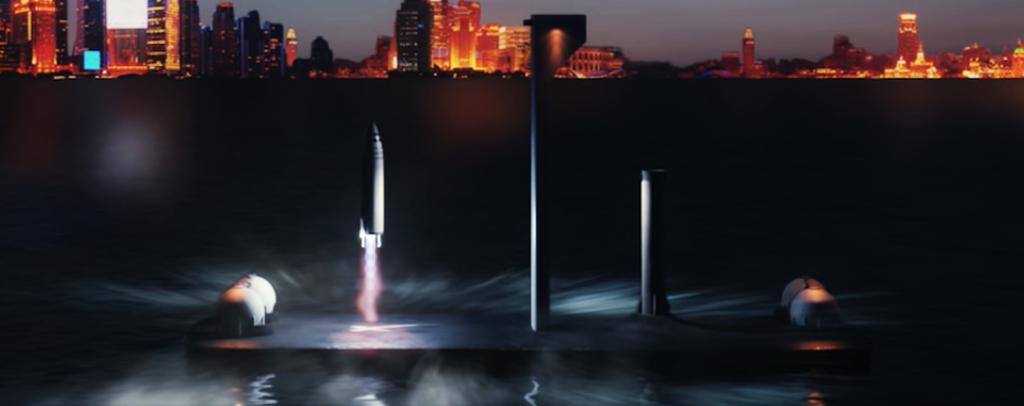

News
SpaceX prioritizes Starship test flights, pauses plans for floating launch pads
President and COO Gwynne Shotwell says that SpaceX has temporarily abandoned plans for floating Starship launch platforms to ensure it’s fully focused on gaining flight experience with the next-generation rocket.
On February 13th, a NASASpaceflight.com forum member reported that a pair of oil rigs were scheduled to leave a Mississippi port for an unknown destination. At one point, those oil rigs – christened Deimos and Phobos after Mars’ moons – were owned by SpaceX. In mid-2020, SpaceX bought the former half-billion-dollar oil rigs for just $7 million. Around the same time, CEO Elon Musk tweeted that SpaceX was “building floating, superheavy-class spaceports for Mars, moon & hypersonic travel around Earth.”
SpaceX’s oil rig purchase was publicly uncovered in January 2021. Since then, however, the company has done very little to Phobos or Deimos. Phobos’ deck was half-cleared in fitful bursts of work, but Deimos was left almost untouched. Now, according to SpaceNews, SpaceX’s second in command says the company sold Phobos and Deimos and has paused work on offshore Starship launch platforms.
The update that's rolling out to the fleet makes full use of the front and rear steering travel to minimize turning circle. In this case a reduction of 1.6 feet just over the air— Wes (@wmorrill3) April 16, 2024
In August 2021, Musk added some additional insight, revealing that the platforms were not a priority and that the only visible work done was the result of SpaceX hiring third parties to clear Phobos’ deck. Ultimately, the project may have been a false start. Speaking in February 2023, Shotwell told reporters that while SpaceX had sold the rigs, she was still confident that “sea-based [launch] platforms” would become a crucial asset in the future.
Perhaps even exceeding CEO Elon Musk’s infamously lofty ambitions, Shotwell said that SpaceX has “designed Starship to be as much like aircraft operations as we possibly can get” in the hopes of enabling “dozens of launches a day, if not hundreds of launches a day.” No rocket family in history has launched more than 61 times in one calendar year, making Shotwell’s Starship cadence target hundreds or even thousands of times more ambitious than a 1980s rocket record that’s still standing four decades later.
It’s unclear if the FAA’s stringent environmental reviews would ever allow SpaceX to get close to that kind of launch cadence using pads built on US soil. SpaceX fought long and hard to receive approval for up to five orbital Starship launches per year out of Boca Chica, Texas. SpaceX has also received approval [PDF] for up to 24 Starship launches per year out of a NASA Kennedy Space Center pad in Cape Canaveral, Florida. And SpaceX is permitted to launch [PDF] up to 70 much smaller Falcon rockets per year from its two existing Cape Canaveral pads.



“Dozens” to “hundreds” of Starship launches per day would be two or three orders of magnitude beyond the highest cadences the FAA has ever permitted. Shotwell’s continued interest in floating platforms is thus unsurprising, as they may be the only way SpaceX can realistically achieve airline-like Starship operations while still coexisting with US regulators.
According to SpaceNews, Shotwell said that SpaceX “really need[s] to fly [Starship] to understand it – to get to know this machine – and then we’ll figure out how we’re going to launch it.” That disciplined focus could be just the thing the Starship program needs. More than eighteen months after SpaceX first fully stacked a two-stage Starship, the rocket still hasn’t attempted an orbital launch. SpaceX has, nonetheless, put a vast amount of money and effort into building, expanding, and optimizing factories and launch facilities for Starship, an orbital rocket that has yet to even partially demonstrate itself.
In essence, SpaceX has made huge gambles on the assumption that a version of Starship mostly resembling what the company is building today will be highly successful, reusable, and reliable. SpaceX’s success with Falcon 9, Falcon Heavy, Dragon, and suborbital Starship testing suggests that it will ultimately be successful, in time. Nonetheless, Shotwell’s apparent desire to conduct orbital Starship launches and gather data before making major investments in new infrastructure (and, hopefully, big design changes and “optimizations”) is a welcome change of pace. Shotwell reportedly assumed oversight of Starbase and Starship in late 2022.

News
Tesla aims to combat common Full Self-Driving problem with new patent
Tesla writes in the patent that its autonomous and semi-autonomous vehicles are heavily reliant on camera systems to navigate and interact with their environment.

Tesla is aiming to combat a common Full Self-Driving problem with a new patent.
One issue with Tesla’s vision-based approach is that sunlight glare can become a troublesome element of everyday travel. Full Self-Driving is certainly an amazing technology, but there are still things Tesla is aiming to figure out with its development.
Unfortunately, it is extremely difficult to get around this issue, and even humans need ways to combat it when they’re driving, as we commonly use sunglasses or sun visors to give us better visibility.
Cameras obviously do not have these ways to fight sunglare, but a new patent Tesla recently had published aims to fight this through a “glare shield.”
Tesla writes in the patent that its autonomous and semi-autonomous vehicles are heavily reliant on camera systems to navigate and interact with their environment.

The ability to see surroundings is crucial for accurate performance, and glare is one element of interference that has yet to be confronted.
Tesla described the patent, which will utilize “a textured surface composed of an array of micro-cones, or cone-shaped formations, which serve to scatter incident light in various directions, thereby reducing glare and improving camera vision.”

The patent was first spotted by Not a Tesla App.
The design of the micro-cones is the first element of the puzzle to fight the excess glare. The patent says they are “optimized in size, angle, and orientation to minimize Total Hemispherical Reflectance (THR) and reflection penalty, enhancing the camera’s ability to accurately interpret visual data.”
Additionally, there is an electromechanical system for dynamic orientation adjustment, which will allow the micro-cones to move based on the angle of external light sources.
This is not the only thing Tesla is mulling to resolve issues with sunlight glare, as it has also worked on two other ways to combat the problem. One thing the company has discussed is a direct photon count.
CEO Elon Musk said during the Q2 Earnings Call:
“We use an approach which is direct photon count. When you see a processed image, so the image that goes from the sort of photon counter — the silicon photon counter — that then goes through a digital signal processor or image signal processor, that’s normally what happens. And then the image that you see looks all washed out, because if you point the camera at the sun, the post-processing of the photon counting washes things out.”
Future Hardware iterations, like Hardware 5 and Hardware 6, could also integrate better solutions for the sunglare issue, such as neutral density filters or heated lenses, aiming to solve glare more effectively.
Elon Musk
Delaware Supreme Court reinstates Elon Musk’s 2018 Tesla CEO pay package
The unanimous decision criticized the prior total rescission as “improper and inequitable,” arguing that it left Musk uncompensated for six years of transformative leadership at Tesla.

The Delaware Supreme Court has overturned a lower court ruling, reinstating Elon Musk’s 2018 compensation package originally valued at $56 billion but now worth approximately $139 billion due to Tesla’s soaring stock price.
The unanimous decision criticized the prior total rescission as “improper and inequitable,” arguing that it left Musk uncompensated for six years of transformative leadership at Tesla. Musk quickly celebrated the outcome on X, stating that he felt “vindicated.” He also shared his gratitude to TSLA shareholders.
Delaware Supreme Court makes a decision
In a 49-page ruling Friday, the Delaware Supreme Court reversed Chancellor Kathaleen McCormick’s 2024 decision that voided the 2018 package over alleged board conflicts and inadequate shareholder disclosures. The high court acknowledged varying views on liability but agreed rescission was excessive, stating it “leaves Musk uncompensated for his time and efforts over a period of six years.”
The 2018 plan granted Musk options on about 304 million shares upon hitting aggressive milestones, all of which were achieved ahead of time. Shareholders overwhelmingly approved it initially in 2018 and ratified it once again in 2024 after the Delaware lower court struck it down. The case against Musk’s 2018 pay package was filed by plaintiff Richard Tornetta, who held just nine shares when the compensation plan was approved.
A hard-fought victory
As noted in a Reuters report, Tesla’s win avoids a potential $26 billion earnings hit from replacing the award at current prices. Tesla, now Texas-incorporated, had hedged with interim plans, including a November 2025 shareholder-approved package potentially worth $878 billion tied to Robotaxi and Optimus goals and other extremely aggressive operational milestones.
The saga surrounding Elon Musk’s 2018 pay package ultimately damaged Delaware’s corporate appeal, prompting a number of high-profile firms, such as Dropbox, Roblox, Trade Desk, and Coinbase, to follow Tesla’s exodus out of the state. What added more fuel to the issue was the fact that Tornetta’s legal team, following the lower court’s 2024 decision, demanded a fee request of more than $5.1 billion worth of TSLA stock, which was equal to an hourly rate of over $200,000.
Delaware Supreme Court Elon Musk 2018 Pay Package by Simon Alvarez
News
Tesla Cybercab tests are going on overdrive with production-ready units
Tesla is ramping its real-world tests of the Cybercab, with multiple sightings of the vehicle being reported across social media this week.

Tesla is ramping its real-world tests of the Cybercab, with multiple sightings of the autonomous two-seater being reported across social media this week. Based on videos of the vehicle that have been shared online, it appears that Cybercab tests are underway across multiple states.
Recent Cybercab sightings
Reports of Cybercab tests have ramped this week, with a vehicle that looked like a production-ready prototype being spotted at Apple’s Visitor Center in California. The vehicle in this sighting was interesting as it was equipped with a steering wheel. The vehicle also featured some changes to the design of its brake lights.
The Cybercab was also filmed testing at the Fremont factory’s test track, which also seemed to involve a vehicle that looked production-ready. This also seemed to be the case for a Cybercab that was spotted in Austin, Texas, which happened to be undergoing real-world tests. Overall, these sightings suggest that Cybercab testing is fully underway, and the vehicle is really moving towards production.
Production design all but finalized?
Recently, a near-production-ready Cybercab was showcased at Tesla’s Santana Row showroom in San Jose. The vehicle was equipped with frameless windows, dual windshield wipers, powered butterfly door struts, an extended front splitter, an updated lightbar, new wheel covers, and a license plate bracket. Interior updates include redesigned dash/door panels, refined seats with center cupholders, updated carpet, and what appeared to be improved legroom.
There seems to be a pretty good chance that the Cybercab’s design has been all but finalized, at least considering Elon Musk’s comments at the 2025 Annual Shareholder Meeting. During the event, Musk confirmed that the vehicle will enter production around April 2026, and its production targets will be quite ambitious.








